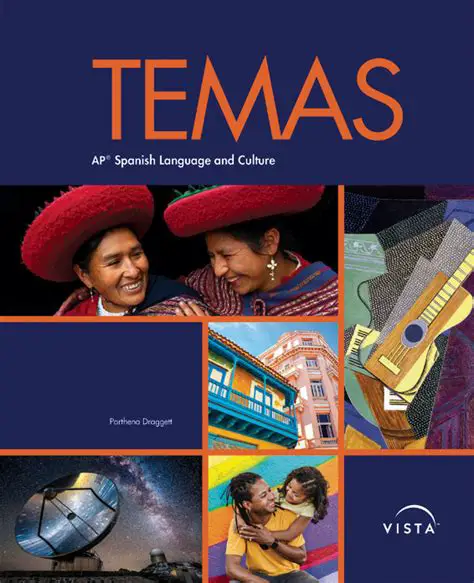Introduction:

The Advanced Placement (AP) Spanish Language and Culture course is designed to immerse students in the complexities of the Spanish language and the rich tapestry of Hispanic culture. By delving into six core themes, students gain a comprehensive understanding of the diverse perspectives, values, and traditions that shape this vibrant linguistic and cultural landscape.
1. Families and Communities
The family serves as a cornerstone of Hispanic society, fostering strong bonds and a sense of identity. AP Spanish students explore the dynamics of family relationships, the importance of community involvement, and the role of tradition in shaping family life.
2. Personal and Public Identities
Individuals in Hispanic cultures navigate multifaceted identities, shaped by personal experiences, cultural heritage, and societal expectations. Students examine the interplay between these influences, exploring how individuals construct and express their identity in various contexts.
3. Global Challenges
The Spanish-speaking world faces pressing global challenges, including environmental degradation, economic inequality, and social injustice. AP Spanish students analyze the impact of these issues on Hispanic societies, examining the perspectives of diverse stakeholders and exploring potential solutions.
4. Beauty and Aesthetics
Hispanic culture is renowned for its vibrant artistic traditions, from literature and music to painting and dance. Students develop an appreciation for the diverse forms of artistic expression, examining the ways in which they reflect the values and aspirations of Hispanic communities.
5. Science and Technology
Technological advancements play a vital role in shaping contemporary Hispanic societies. AP Spanish students investigate the impact of science and technology on health, education, and the environment, exploring both the benefits and challenges associated with these advancements.
6. Contemporary Life
Hispanic culture is constantly evolving, influenced by globalization and demographic shifts. AP Spanish students examine the dynamic nature of contemporary Hispanic life, exploring changes in family structure, gender roles, and the role of media in shaping cultural norms.
Benefits of Studying Temas AP Spanish Language and Culture:
Improved Language Proficiency:
* Students enhance their Spanish language skills through authentic materials and immersive experiences.
* They develop fluency in speaking, listening, reading, and writing, preparing them for advanced study and future careers.
Cultural Awareness:
* Students gain a deep understanding of Hispanic culture, its values, traditions, and global influences.
* This cultural knowledge enhances empathy, respect, and intercultural communication skills.
Critical Thinking Skills:
* AP Spanish students engage in critical analysis of texts and discussions, developing their ability to synthesize information, evaluate arguments, and form independent judgments.
* These critical thinking skills are essential for success in higher education and professional life.
College Readiness:
* The AP Spanish Language and Culture exam prepares students for success in college-level Spanish courses.
* Earning a high score on the exam can exempt students from language placement tests and open doors to advanced language study.
Careers in Spanish:
* Proficiency in Spanish is a valuable asset in various careers, including business, government, healthcare, education, and international relations.
* AP Spanish students gain the language and cultural skills necessary to pursue these opportunities.
Tables:
Table 1: Themes and Key Concepts
| Theme | Key Concepts |
|---|---|
| Families and Communities | Family structure, cultural expectations, community involvement |
| Personal and Public Identities | Identity formation, social norms, cultural heritage |
| Global Challenges | Environmental issues, economic inequality, social injustice |
| Beauty and Aesthetics | Artistic traditions, cultural expression, aesthetic values |
| Science and Technology | Technological advancements, impact on society, ethical considerations |
| Contemporary Life | Changing family structures, gender roles, media influence |
Table 2: AP Spanish Language Skills
| Skill | Description |
|---|---|
| Listening | Comprehending spoken Spanish in various contextos |
| Speaking | Engaging in fluid and meaningful conversations |
| Reading | Interpreting written materials for information and understanding |
| Writing | Expressing ideas and information in cohesive and grammatically correct Spanish |
Table 3: Benefits of AP Spanish Language and Culture
| Benefit | Description |
|---|---|
| Enhanced Language Proficiency | Fluency in Spanish language skills |
| Cultural Awareness | Deep understanding of Hispanic culture and values |
| Critical Thinking Skills | Ability to analyze and evaluate complex issues |
| College Readiness | Preparation for college-level Spanish courses |
| Career Opportunities | Opening doors to careers requiring Spanish proficiency |
Table 4: Statistical Data
| Statistic | Source |
|---|---|
| Over 90% of AP Spanish Language and Culture students pass the exam | College Board |
| AP Spanish students score significantly higher on college Spanish placement exams than non-AP students | College Board |
| Students who study Spanish are more likely to pursue careers in international business and government | American Council on the Teaching of Foreign Languages |
Conclusion:
The AP Spanish Language and Culture course offers students a transformative learning experience that fosters language proficiency, cultural awareness, critical thinking skills, and college and career readiness. By immersing themselves in the six core themes, students develop a deep understanding of the multifaceted nature of Hispanic civilization and its impact on the global stage.
